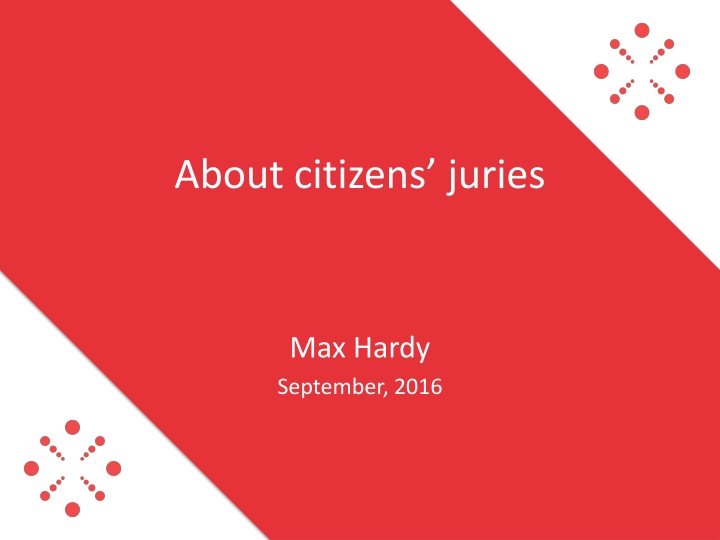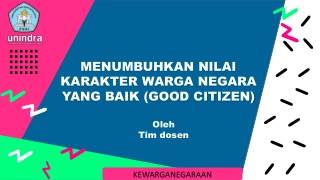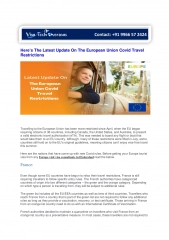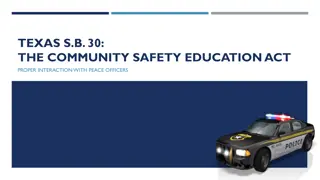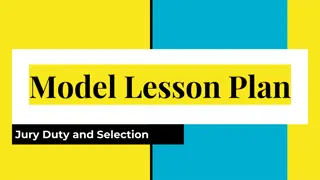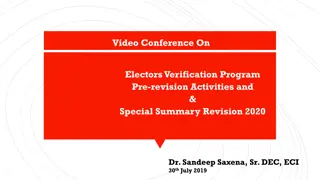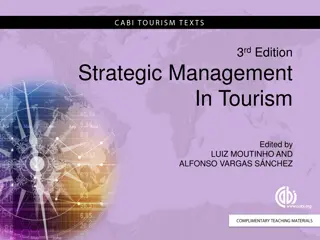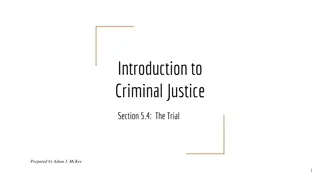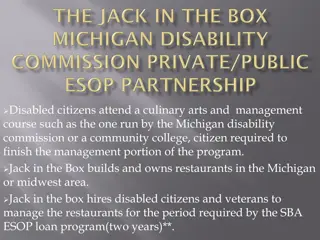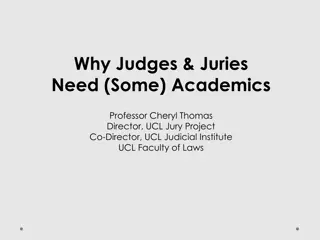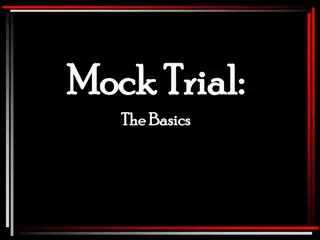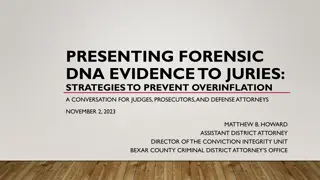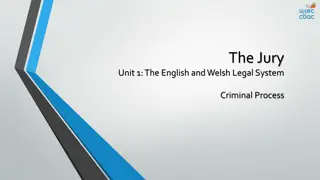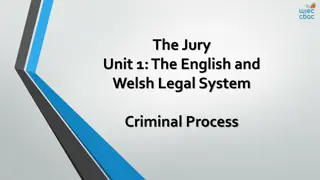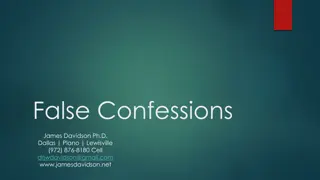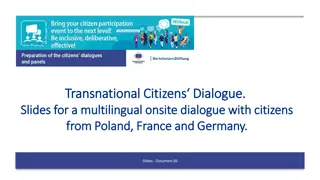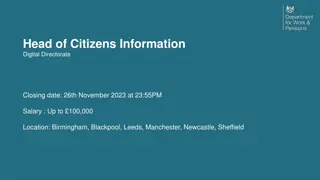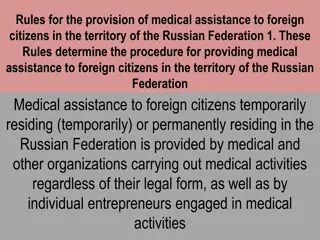About citizens’ juries
This content discusses the evolving role of citizens in governance and public administration, highlighting the shift from rulers to partners. It also presents examples of topics for citizens' juries, common objections, and risks associated with such processes. The emphasis is on engaging the broader community in decision-making to foster collaboration and responsiveness.
Download Presentation

Please find below an Image/Link to download the presentation.
The content on the website is provided AS IS for your information and personal use only. It may not be sold, licensed, or shared on other websites without obtaining consent from the author.If you encounter any issues during the download, it is possible that the publisher has removed the file from their server.
You are allowed to download the files provided on this website for personal or commercial use, subject to the condition that they are used lawfully. All files are the property of their respective owners.
The content on the website is provided AS IS for your information and personal use only. It may not be sold, licensed, or shared on other websites without obtaining consent from the author.
E N D
Presentation Transcript
About citizens juries Max Hardy September, 2016
Why the growing interest in deliberative processes? FOMO We need to hear what the cross-section of the broader community thinks, not just those who are really unhappy
An Evolutionary Continuum Adapted from Eran Vigoda-Gadot Role of Citizens Citizens as subjects Citizens as voters Citizens as customers Citizens as partners Old New Role of Governance and Public Administration G & PA as rulers G & PA as trustees G & PA as managers G & PA as partners Old New Type of interaction Coerciveness Delegation Collaboration Responsiveness Old New
Examples of issues/topics Managing stray/feral dogs and cats policy South Australia NDIS review of pilot sites Curfews Adelaide and Sydney Planning controls City of Yarra Rate capping/levies/tariffs many Co-designing air quality monitoring system EPA Wastewater solutions at 12 Apostles PV and WW Speed limits and street redesign VicRoads Redevelopment of open space/golf course Bayside Reform of governance Geelong Nuclear Waste South Australia
Common objections or concerns They might come up with a wish-list we can t implement This is one for the experts; not lay people Isn t our Council a Citizens Jury? Internal How do we know we won t end up with people who are drunkards, or idiots? I don t think we can afford to have ordinary citizens make such important decisions How do we know the process is not social engineering to get solution Council wants Isn t this just a way to silence our Council s biggest critics? External
Risks with citizens juries Stakeholders can feel marginalised Sponsoring organisations may see as a way to disempower those with different points of view. Broader community can feel left out, and be left out. Stakeholders will not go on the same journey as jurors, and may well still be polarised Stakeholders may choose not to participate and lobby decision-makers directly Bright, newish shiny thing used inappropriately
Benefits of citizens juries Potential for the really deep dive Transformative for jurors Jurors can advocate for process and outcome Those with strong interests are required to pitch to citizens (rather than claiming to speak on their behalf when lobbying) Clearer accountability with process outputs and ultimate decisions made
Citizens Jury classic model 12-24 randomly selected against stratified criteria Usually 3-5 consecutive days in duration Overseen by stakeholder steering committee, who choose witnesses to give evidence Commitment by decision- makers to seriously consider and publicly respond to recommendations. Consensus verdict expected though majority reports still useful
Variables Size of the jury/deliberative panel Times/duration of process How it is termed Composition Level of influence Incentives Remits Codesign vs choosing between options
Imperatives for citizens juries Ensuring it s do-able Ensuring it s ethical 1. Commitment of decision-makers 1. Process is sufficiently funded 2. Remit is scoped well 2. Jurors independently recruited 3. Sessions structured to assist jurors to address remit 3. Evidence not stacked 4. Sufficient time for jurors to process information and deliberate 4. Independent facilitation 5. Sufficient time for jurors to prepare report Ensuring it s influential 1. Jurors will stand behind report 2. Decision-makers are impressed by the jurors and process; and respond publicly 3. Stakeholders believe it was run well regardless of recommendations
EthicalImperatives 1. Gaining clear commitment from sponsors/decisionmakers Are the open to it being different to their preferred outcome? Are they really curious to know what citizens will support/recommend? Are they willing for jurors report to be made public unedited? Have they considered the relative merits of other processes? Are they willing to respond publicly to their recommendations?
Do-ableImperatives 2. Well-scoped remit If the remit is really broad such as How might this state best address it s key health challenges over the next 20 years? it makes the jury s task, and organisers/facilitators very difficult. Yet, even with such a remit wisdom can emerge. Research tends to point to CJs being most useful for convergence focusing on making choices between carefully crafted options, yet with room to craft Stakeholder confidence in the remit itself is very important. If the remit is extremely narrow then the value a jury can add might be missed. Example Should we have designated bike lanes on Wellington St?
Do-ableImperatives 3-5. Design and structure Equal time for content delivery and deliberation is a useful guide. Lots of work, time and skill required. Encourage jurors to learn as much as they can from all witnesses. Not uncommon for extra time to be allocated after sitting days for jurors to finalise their report. This is for explaining and documenting rationale, not revisiting the verdict.
Influence imperatives 1. Juries standing behind their report Check in regularly to ensure satisfaction with process. Whatever happens, it MUST be the juror s report! Juries will make judgments throughout as to whether they feel the process is genuine. If sponsor or facilitators are not genuine they will know! Not uncommon for jurors to make public comments in support of process
When I came into this process all I could see was a two-dimensional circle. Now I can see a three-dimensional object and I can t go back.
Influence imperatives 2. Stakeholders believe process well run They believe facilitators behave independently Believe there is an appropriate balance of evidence-givers (witnesses) Stakeholders believe their own perspectives have been well put, understood and appreciated.
Its such an honour to contribute to this process. And it s great for a change that, unlike my shawl, I ll be able to see the shades of grey .
